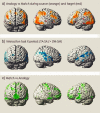Specialization of the rostral prefrontal cortex for distinct analogy processes
- PMID: 20156841
- PMCID: PMC2951846
- DOI: 10.1093/cercor/bhq012
Specialization of the rostral prefrontal cortex for distinct analogy processes
Abstract
Analogical reasoning is central to learning and abstract thinking. It involves using a more familiar situation (source) to make inferences about a less familiar situation (target). According to the predominant cognitive models, analogical reasoning includes 1) generation of structured mental representations and 2) mapping based on structural similarities between them. This study used functional magnetic resonance imaging to specify the role of rostral prefrontal cortex (PFC) in these distinct processes. An experimental paradigm was designed that enabled differentiation between these processes, by temporal separation of the presentation of the source and the target. Within rostral PFC, a lateral subregion was activated by analogy task both during study of the source (before the source could be compared with a target) and when the target appeared. This may suggest that this subregion supports fundamental analogy processes such as generating structured representations of stimuli but is not specific to one particular processing stage. By contrast, a dorsomedial subregion of rostral PFC showed an interaction between task (analogy vs. control) and period (more activated when the target appeared). We propose that this region is involved in comparison or mapping processes. These results add to the growing evidence for functional differentiation between rostral PFC subregions.
Figures



Similar articles
-
An fMRI investigation of cognitive stages in reasoning by analogy.Brain Res. 2010 Jun 25;1342:63-73. doi: 10.1016/j.brainres.2010.04.039. Epub 2010 Apr 25. Brain Res. 2010. PMID: 20423699
-
Analogical reasoning and prefrontal cortex: evidence for separable retrieval and integration mechanisms.Cereb Cortex. 2005 Mar;15(3):239-49. doi: 10.1093/cercor/bhh126. Epub 2004 Jul 6. Cereb Cortex. 2005. PMID: 15238433 Clinical Trial.
-
A hierarchy for relational reasoning in the prefrontal cortex.Cortex. 2011 May;47(5):588-97. doi: 10.1016/j.cortex.2010.04.008. Epub 2010 May 27. Cortex. 2011. PMID: 20537619
-
The cognition and neuroscience of relational reasoning.Brain Res. 2012 Jan 5;1428:13-23. doi: 10.1016/j.brainres.2010.11.080. Epub 2010 Dec 1. Brain Res. 2012. PMID: 21129363 Review.
-
The Neural Correlates of Analogy Component Processes.Cogn Sci. 2022 Mar;46(3):e13116. doi: 10.1111/cogs.13116. Cogn Sci. 2022. PMID: 35297092 Review.
Cited by
-
Metaphorical motion in mathematical reasoning: further evidence for pre-motor implementation of structure mapping in abstract domains.Cogn Process. 2013 Aug;14(3):217-29. doi: 10.1007/s10339-013-0555-3. Epub 2013 Mar 5. Cogn Process. 2013. PMID: 23459865
-
Development of abstract thinking during childhood and adolescence: the role of rostrolateral prefrontal cortex.Dev Cogn Neurosci. 2014 Oct;10:57-76. doi: 10.1016/j.dcn.2014.07.009. Epub 2014 Aug 12. Dev Cogn Neurosci. 2014. PMID: 25173960 Free PMC article. Review.
-
Frontal lobe neurology and the creative mind.Front Psychol. 2014 Jul 23;5:761. doi: 10.3389/fpsyg.2014.00761. eCollection 2014. Front Psychol. 2014. PMID: 25101029 Free PMC article. Review.
-
Not all analogies are created equal: Associative and categorical analogy processing following brain damage.Neuropsychologia. 2012 Jun;50(7):1372-9. doi: 10.1016/j.neuropsychologia.2012.02.022. Epub 2012 Mar 6. Neuropsychologia. 2012. PMID: 22402184 Free PMC article.
-
General and specialized brain correlates for analogical reasoning: A meta-analysis of functional imaging studies.Hum Brain Mapp. 2016 May;37(5):1953-69. doi: 10.1002/hbm.23149. Epub 2016 Mar 25. Hum Brain Mapp. 2016. PMID: 27012301 Free PMC article.
References
-
- Badre D. Cognitive control, hierarchy, and the rostro-caudal organization of the frontal lobes. Trends Cogn Sci. 2008;12:193–200. - PubMed
-
- Blanchette I, Dunbar K. How analogies are generated: the roles of structural and superficial similarity. Mem Cogn. 2000;28:108–124. - PubMed
-
- Bowdle BF, Gentner D. The career of metaphor. Psychol Rev. 2005;112:193–216. - PubMed
-
- Braver TS, Bongiolatti SR. The role of frontopolar cortex in subgoal processing during working memory. Neuroimage. 2002;15:523–536. - PubMed
-
- Buckner RL, Andrews-Hanna JR, Schacter DL. The brain's default network: anatomy, function, and relevance to disease. Ann N Y Acad Sci. 2008;1124:1–38. - PubMed
Publication types
MeSH terms
Grants and funding
LinkOut - more resources
Full Text Sources
Miscellaneous

